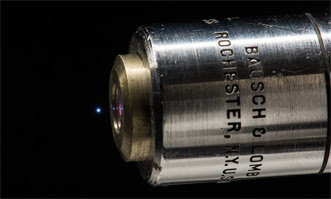Microplasma summoned out of thin air by low-energy laser pulses can be used as a source of broadband terahertz radiation for spectroscopy.
Terahertz imaging needs only a narrow range of terahertz frequency to, for example, nondestructively look through layers of paint. But broader frequency range is necessary to differentiate the spectral "fingerprints" of various chemicals and identify threats like poisons in food or contraband and explosives in baggage.
"If you were only using a source of radiation with a range around 1 THz, you might not be able to tell two different materials apart at low spectral resolution, as you might only have one feature in the spectrum to compare," said Fabrizio Buccheri, doctoral student at The Institute of Optics at University of Rochester. "If instead you compare their spectra over a range of tens of terahertz, the fingerprints of the two materials will differ, and the materials will be more clearly identifiable, even at lower spectral resolutions."

A microplasma is created by focusing intense laser pulses in air. Besides visible light, the microplasma emits electromagnetic pulses at terahertz frequencies that can be used to detect complex molecules, such as explosives and drugs. Courtesy of J. Adam Fenster/University of Rochester.
Approaches to developing plasma as a broadband source of terahertz radiation have commonly used an elongated plasma generated by combining two laser beams of different frequencies. This technique, referred to as the "two-color" approach, requires powerful, expensive lasers.
A "one-color" approach, pioneered by Harald Hamster and colleagues in 1993, uses single-laser frequency to generate plasma. This approach, however, required even higher laser energies and therefore was not explored further until now.
Buccheri and professor Xi-Cheng Zhang explored alternative approaches to plasma generation using azimuthal or radial light polarization. In these states, the electric field is either perpendicular to the radial axis or radial at each given point.
"I wanted to see if by creating a plasma with a laser in one of these 'weirder' polarization states, I could make the terahertz emission more efficient," said Buccheri. "That didn’t work. But when I understood why it didn't work, I really understood the underlying physics."
The researchers' next step was to replace elongated plasmas, with lengths ranging from a few millimeters to several centimeters, with microplasmas. They discovered these could be produced with laser pulse energy <1 μJ in ambient air.
An advantage of the one-color approach to terahertz radiation is that terahertz waves propagate in a different direction to the laser beam, which may make it easier to couple the terahertz waves to a wave guide on a microchip, for example.
Fine-tuning the type of laser used and using gases other than air could enable microplasma generation at even lower energies, Buccheri said.
Funding came from the National Science Foundation and Army Research Office.
The research was published in Optica (doi: 10.1364/optica.2.000366).
For more information, visit www.rochester.edu.